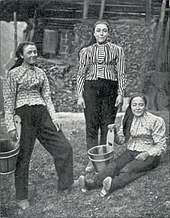Swiss people
| Total population | |
|---|---|
| c. 8–9 million (2016)[lower-alpha 1] | |
| Regions with significant populations | |
|
| |
| 0.8 million (2016)[2] | |
| c. 1.5 million[3] | |
| Languages | |
|
Swiss German Swiss French Swiss Italian Romansh | |
| Religion | |
|
Roman Catholicism and Protestantism (mainly Swiss Reformed)[4] | |
| Related ethnic groups | |
| Liechtensteiners, Germans, Austrians, French and Italians | |
The Swiss (German: die Schweizer, French: les Suisses, Italian: gli Svizzeri, Romansh: ils Svizzers) are the citizens of Switzerland,[lower-alpha 2] or people of Swiss ancestry.
The number of Swiss nationals has grown from 1.7 million in 1815 to 7 million in 2016. More than 1.5 million Swiss citizens hold multiple citizenship.[5] About 11% of citizens live abroad (0.8 million, of whom 0.6 million hold multiple citizenship). About 60% of those living abroad reside in the European Union (0.46 million). The largest groups of Swiss descendants and nationals outside Europe are found in the United States and Canada.
Although the modern state of Switzerland originated in 1848, the period of romantic nationalism, it is not a nation-state, and the Swiss are not usually considered to form a single ethnic group, but a confederacy (Eidgenossenschaft) or Willensnation ("nation of will", "nation by choice", that is, a consociational state), a term coined in conscious contrast to "nation" in the conventionally linguistic or ethnic sense of the term.
The demonym Swiss (formerly in English also Switzer) and the name of Switzerland, ultimately derive from the toponym Schwyz, have been in widespread use to refer to the Old Swiss Confederacy since the 16th century.[6]
Ethno-linguistic composition
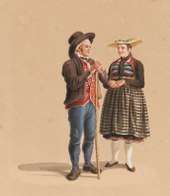

The ethno-linguistic composition of the territories of modern Switzerland includes the following components:
- The German-speaking Swiss (Deutschschweizer), i.e. Alemannic German, historically amalgamated from the Gallo-Roman population and the Alemanni. Closely related German-speaking peoples are the Alsatians, the Swabians and the Vorarlbergians. German speakers (including German immigrants) accounted for 63% of population as of 2015.
- Speakers of High Alemannic, roughly divided into an Eastern (Zürich, Lake Lucerne, Eastern Switzerland) and a Western (Bernese, Solothurn, Western Aargau, Basel-Land and Fricktal) subgroup, with most dialects of Aargau and Lucerne transitional between the groups.
- Speakers of Low Alemannic in Basel and the Lake Constance area
- Speakers of Highest Alemannic in the Bernese Oberland, Upper Valais and the Walser settlements in Central Switzerland, Grisons and Ticino
- The French-speaking Swiss (Romands), traditionally speaking Franco-Provençal dialects, today largely assimilated to the standard French language (Swiss French), amalgamated from the Gallo-Roman population and Burgundians (the historical Upper Burgundy). Romands are considered a distinct Romance people.[8] They are closely related to the French (especially those of Franche-Comté). They are referred to as Welsche (singlar Welscher) in Swiss German. French speakers (including French immigrants) accounted for 23% of population as of 2015.
- The Italian-speaking Swiss (Svizzeri italiani), traditionally speakers of Lombard language (Ticinese variety) today partly assimilated to the standard Italian language, amalgamated from Raetians and Lombards. They are closely related to the Italians (especially Lombards and Piedmontese). Italian-speakers (including Italian immigrants) accounted for 8.4% of population as of 2015.
- The Romansh, speakers of the Romansh language, settling in parts of the Grisons, historically of Raetic stock. Romansh speakers accounted for 0.6% of population as of 2015.
The core Eight Cantons of the Swiss Confederacy were entirely Alemannic-speaking, and German speakers remain the majority. However, from as early as the 15th century, parts of French-speaking Vaud and Italian-speaking Ticino were acquired as subject territories by Berne and Uri, respectively. The Swiss Romandie was formed by the accession of French-speaking Geneva and Neuchâtel and the partly francophone Valais and Bernese Jura (formerly part of the Prince-Bishopric of Basel) to the Restored Swiss Confederacy in 1815. Romansh was formerly considered a group of Italian dialects, but Switzerland declared Romansh a national language in 1938 in reaction to the fascist Italian irredentism at the time.
As elsewhere in Western Europe, immigration to Switzerland has increased dramatically since the 1960s, so that a large proportion of the resident population of Switzerland are now not descended or only partially descended from the core ethno-linguistic groups listed above. As of 2011, 37% of total resident population of Switzerland had immigrant background.[9] As of 2016, the most widely used foreign languages were English, Portuguese, Albanian, Serbo-Croat and Spanish, all named as a "main language" by more than 2% of total population (respondents could name more than one "main language").[10]
Cultural history and national identity
The Swiss populace historically derives from an amalgamation of Gallic or Gallo-Roman, Alamannic and Rhaetic stock. Their cultural history is dominated by the Alps, and the alpine environment is often cited as an important factor in the formation of the Swiss national character.[11] For example, the "Swiss illness", the condition of Swiss mercenaries pining for their mountainous native home, became prototypical of the medical condition of nostalgia ("homesickness") described in the 17th century.
In early modern Switzerland, the Swiss Confederacy was a pact between independent states within the Holy Roman Empire. The populations of the states of Central Switzerland considered themselves ethnically or even racially separate: Martin Zeiller in Topographia Germaniae (1642) reports a racial division even within the canton of Unterwalden, the population of Obwalden being identified as "Romans", and that of Nidwalden as "Cimbri" (viz. Germanic), while the people of Schwyz were identified as of Swedish ancestry, and the people of Uri were identified as "Huns or Goths".[12]
Modern Switzerland is atypical in its successful political integration of a multiethnic and multilingual populace, and is often cited as a model for new efforts at creating unification, as in the European Union's frequent invocation of the Swiss Confederate model.[13] Because the various populations of Switzerland share language, ethnicity, and religion not with each other but with the major European powers between whom Switzerland during the modern history of Europe found itself positioned, a policy of domestic plurality in conjunction with international neutrality became a matter of self-preservation.[14] Consequently, the Swiss elites during the period of the formation of nation states throughout Europe did not attempt to impose a national language or a nationalism based on ethnicity, instead pushing for the creation of a civic nation grounded in democratic ideology, common political institutions, and shared political ritual. Political allegiance and patriotism was directed towards the cantons, not the federal level, where a spirit of rivalry and competition rather than unity prevailed. C. G. Jung advanced the view that this system of social order was one of a "chronic state of mitigated civil war" which put Switzerland ahead of the world in a civilizatory process of "introverting" warlike aggression.[15] A similar view is attributed to Gottfried Keller, who is cited to the effect that the Swiss Confederacy could not exist without the endemic rivalry between cantons.[16]
From the 19th century there were conscious attempts to foster a federal "Pan-Swiss" national identity that would replace or alleviate the cantonal patriotisms. Among the traditions enlisted to this end were federal sharpshooting competitions or tirs, because they were one of the few recognized symbols of pan-Swiss identity prior to the creation of the 1815 Confederation and because they traditionally involved men from all levels of society, including the peasants, who in Romantic nationalism had become ideologically synonymous with liberty and nationhood.[17] An additional symbol of federal national identity at the federal level was introduced with the Swiss national holiday in 1889. The bonfires associated with the national holiday have become so customary since then that they have displaced the Funken traditions of greater antiquity.
Identification with the national symbolism relating to the Old Swiss Confederacy was especially difficult for the cantons which had been joined to the Helvetic Republic in 1798 without any prior membership in the Swiss Confederacy, and which were given the status of Swiss cantons only after the end of the Napoleonic era. These specifically include Grisons, Valais, Ticino, Vaud and Geneva. St. Gallen is a special case in a different sense, being a conglomerate of various historical regions created in 1803; in this case, patriotism may attach itself even to sub-cantonal entities, such as the Toggenburg. Similarly, due to the historical imperialism of the canton of Berne, there is considerable irredentism within the Bernese lands, most visibly in the Bernese Jura but to a lesser extent also in parts of the Bernese Oberland such as Hasli.
Citizenship and naturalization
Swiss citizenship is still primarily citizenship in one of the Swiss cantons, and the naturalization of foreign citizens is the privilege of the cantons. No Swiss passports were issued prior to 1915, more than 60 years after the establishment of the modern Swiss Confederation. Prior to 1915, citizens held passports issued by their cantons, the Confederation being considered as a federation of the cantons, not a state composed of natural persons as its citizens.
The Swiss Constitution of 1848 regulated certain rights that the cantons were required to grant to citizens of other cantons, such as the right of residence (in the case of naturalized citizens after a period of five years).[18] The Swiss Constitution of 1874, which remained in force (with revisions) until 1999, defined Swiss citizenship as inherited from cantonal citizenship: Jeder Kantonsbürger ist Schweizer Bürger ("every citizen of a canton is a Swiss citizen").[19] In the preamble to the current Swiss Constitution of 1999, a "Swiss People" (Schweizervolk) is invoked alongsides "the Cantons" as sovereign entity, and article 1 reads "The People and the Cantons [...] form the Swiss Confederation." Article 37 still defines Swiss citizenship as inherited from communal and cantonal citizenship: "Any person who is a citizen of a commune and of the Canton to which that commune belongs is a Swiss citizen."[20]
As Swiss citizenship is entirely based on jus sanguinis, the place of origin rather than the place of birth is recorded in identity documents. As Swiss citizenship is tied to the cantonal citizenship associated with the "place of origin" (Heimatort or Bürgerort "home commune, commune of citizenship"), a citizen's place of origin is inherited from his or her father (from the mother if born out of wedlock or if the father holds no citizenship). The significance of the place of origin outside of the naturalization procedure has been gradually abolished in the early 21st century. Since 2012, the municipality or canton of a citizen's place of origin is no longer responsible for providing social welfare to that citizen.[21] Since 2013, a woman no longer acquires the place of origin of her husband upon marriage.[22]
While the cantons are responsible for naturalization, federal Swiss nationality law regulates minimal requirements necessary for naturalization. These requirements were significantly reduced in a 2018 revision of the law, allowing naturalization after a minimal period of residence of ten years, and in certain cases as little as five years (naturalization of spouses and children of Swiss citizens; years of residence at ages 8 to 18 count double). A further requirement is that the applicant be "well integrated" and "familiar with life in Switzerland", and must have both oral and written competence in one of the national languages of Switzerland.[23] The federal law just specifies minimal requirements for naturalization, and cantons are free to introduce more stringent requirements.[24] In practice, the cantons delegate the actual procedure of naturalization to the communes.
With more than 20% of the population resident aliens, Switzerland has one of the highest ratios of non-naturalized inhabitants in Europe (comparable to the Netherlands; roughly twice the ratio of Germany). In 2003, 35,424 residents were naturalized, a number exceeding net population growth. Over the 25-year period of 1983 to 2007, 479,264 resident foreigners were naturalized, yearly numbers rising gradually from below 10,000 (0.1%) in the 1980s to above 40,000 (0.6%) in the 2000s.[25] Compare the figure of 0.2% (140,795) in the United Kingdom (2004).[26]
Genetics
The genetic composition of the Swiss population is similar to that of Central Europe in general. Switzerland is on one hand at the crossroads of several prehistoric migrations, while on the other hand the Alps acted as a refuge in some cases. Genetic studies found the following haplogroups to be prevalent:
Gallery
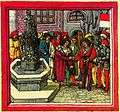
 Patrician dress of Zürich (early 18th century)
Patrician dress of Zürich (early 18th century) People wearing Zürich folk costume in a rowing boat on Lake Zürich (Joseph Reinhart 1802)
People wearing Zürich folk costume in a rowing boat on Lake Zürich (Joseph Reinhart 1802) Bernese folk costumes (1810)
Bernese folk costumes (1810) Folk dress of Uri and Zürich (musicians), Appenzell (f) and Bern (m), Fricktal (f) and Unterwalden (m), Thurgau (f) and Vaud (m), Appenzell (m) and Berne (f) (dancers), Franz Niklaus König (1828)
Folk dress of Uri and Zürich (musicians), Appenzell (f) and Bern (m), Fricktal (f) and Unterwalden (m), Thurgau (f) and Vaud (m), Appenzell (m) and Berne (f) (dancers), Franz Niklaus König (1828) Folk costume of Zug, Solothurn and Appenzell (1820s)
Folk costume of Zug, Solothurn and Appenzell (1820s)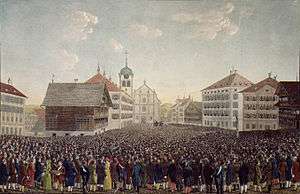 1814 Landsgemeinde in Trogen, Appenzell (Johann Jakob Mock, c. 1820)
1814 Landsgemeinde in Trogen, Appenzell (Johann Jakob Mock, c. 1820) Der Schulspaziergang ("School Promenade", Albert Anker 1872), representing Pestalozzi's liberal approach to education[35]
Der Schulspaziergang ("School Promenade", Albert Anker 1872), representing Pestalozzi's liberal approach to education[35]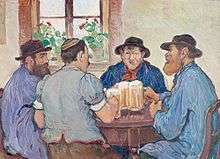 Fribourg farmers in the tavern (François Louis Jaques 1923)
Fribourg farmers in the tavern (François Louis Jaques 1923)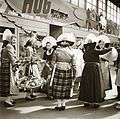 Women in folk costume (1939)
Women in folk costume (1939) Alphorn players in a folklore festival in Lucerne (2008)
Alphorn players in a folklore festival in Lucerne (2008)
See also
![]()
Notes
- ↑ Collectively the 7 million citizens plus the estimated figure of 1.5 million non-citizens abroad with self-reported Swiss ancestry.
- ↑ The term is sometimes extended to include the descendants of Swiss emigrant, see e.g. "Swiss". New Oxford American Dictionary. Conversely, being born in Switzerland does not give an individual Swiss citizenship automatically (there are three levels of alien citizens status in Switzerland), so that there are numerous second generation legal aliens who are technically "natives of Switzerland" without being considered Swiss.
References
- ↑ "Permanent resident population by migration status (2016)". Swiss Federal Statistical Office. Retrieved 2018-04-20. Swiss citizens: 5.324 million (aged 15 or over, of whom 0.862 million naturalized) + 0.920 million (under 15).
- ↑ "Auslandschweizerstatistik 2016" (pdf) (in German). Retrieved 20 April 2018. : total: 775k, single citizenship: 205k. Geographical distribution: Europe: 482k (France: 201k, Germany: 89k, Italy 52k); Americas: 185k (USA 81k, Canada 40k); Oceania 81k; Asia: 54k; Africa: 22k.
- ↑ Swiss Americans: 917k ±20k (Results – Community Survey 2013, includes 80k Swiss citizens with residence in the US) Swiss Canadian: 147k (26k "single ethnic", 121k "multi-ethnic" responses; includes 40k Swiss citizens with residence in Canada) ("Ethnic Origin, 2011 National Household Survey". Statistics Canada. ) Swiss Argentine: 300k (Ministerio de Relaciones Exteriores y Culto de la República Argentina. "La emigración suiza a la Argentina (Swiss emigration to Argentina)" (in Spanish). Retrieved 21 February 2014. ). Swiss Chilean: 100k (actual supera los 100.000 ciudadanos, la mayor de América Latina" Archived 2014-10-16 at the Wayback Machine.) Swiss Brazilian: 80k (História, Ciências, Saúde-Manguinhos - From Nova Friburgo to Fribourg in writing: Swiss colonization seen by the immigrants. Swiss Australian: 12k by birth, 29k by ancestry (2011 census).
- ↑ Ständige Wohnbevölkerung ab 15 Jahren nach Religionszugehörigkeit. Swiss Central Statistical Office 2015 Report. N.b.: the report contains data of the statistical analyses of the years 2010, 2011, 2012, 2013, 2014, 2015.
- ↑ 916k out of 5,293k of permanent residents of Switzerland aged 15 and over ("Ständige Wohnbevölkerung ab 15 Jahren nach doppelter Staatszugehörigkeit (2016)" (in German). Retrieved 20 April 2018. ) plus 570k out of 775k Swiss abroad ("Auslandschweizerstatistik 2016" (pdf) (in German). Retrieved 20 April 2018. ).
- ↑ "Schwyz". New Oxford American Dictionary.
- ↑ Painting commissioned for the chamber of the Council of States in the Federal Palace (see de:Die Landsgemeinde).
- ↑ Minahan, James (2000). One Europe, Many Nations: A Historical Dictionary of European National Groups. Greenwood Publishing Group. p. 545. ISBN 0313309841.
The Romands are a distinct Romance people
- ↑ "Population résidante permanente de 15 ans et plus, ventilée selon le statut migratoire et le canton". Office fédéral de la statistique. Archived from the original on 16 November 2013. Retrieved 14 August 2013.
- ↑ Ständige Wohnbevölkerung nach Hauptsprachen 2016, BFS, 28 February 2018.
- ↑ "Some landscapes were highlighted because they were considered essential in the building of the nation and the shaping of its culture. This was most obvious in Switzerland where the Swiss character was forged by the daily confrontation with the difficult mountainous environment of the Alps. Lunn (1963) suggests that the wonderful scenery gave those who inhabited it an opportunity to develop a sense of dignity and grandeur." Niamh Moore, Yvonne Whelan, Heritage, memory and the politics of identity: new perspectives on the cultural landscape, Ashgate Publishing, 2007, ISBN 978-0-7546-4008-0, p. 88.
- ↑ Ferdinand Vetter, Ueber die Sage von der Herkunft der Schwyzer und Oberhasler aus Schweden und Friesland, Bern 1877, 10f.
- ↑ Hartley-Moore (2007)
- ↑ Kohn 1956:15–20
- ↑ Frank McLynn, Carl Gustav Jung (1997), ISBN 978-0-312-15491-2, chapter 1. "Jung advanced the paradox that the tolerable social order in Switzerland was a result of having `introverted' war; Switzerland was ahead of the rest of the world in that it was in a chronic state of mitigated civil war and did not direct its aggression outwards."
- ↑ Hartley-Moore (2007:213f.): "Localized equivalents of nationalist symbols were also essential to the creation of Swiss civil society. Rather than allowing a centralized federal government to force assimilation to a national ideal, Swiss policy nourished individual characteristics of different regional and language groups" throughout the country. In the Swiss model, pride in local identity is to some degree synonymous with loyalty to the larger state; national identity is nurtured through local 'patriotism.' As Gottfried Keller argued in the nineteenth century, 'Without cantons and without their differences and competition, no Swiss federation could exist'."
- ↑ Hartley-Moore (2007), citing Kohn 1956:78.
- ↑ Constitution of 1848 Art. 43. The requirement of adherence to a Christian confession in the 1848 version was dropped in 1866.
- ↑ [www.verfassungen.de/ch/verf74-i.htm Constitution of 1874], Art. 43.
- ↑ Authoritative German, French and Italian as well as non-authoritative Romansh and English texts of Federal Constitution of the Swiss Confederation of 18 April 1999 (SR 101)
- ↑ Daniel Friedli, Der Heimatort wird irrelevant, NZZ 8 January 2012.
- ↑ Swiss nationality law, Art. 161 ZGB.
- ↑ Regular naturalisation Facilitated naturalisation
- ↑ "Naturalisation: on ne devient pas Suisse partout de la même façon | 24 heures". Archives.24heures.ch. 2011-03-22. Archived from the original on 2013-06-28. Retrieved 2013-09-06.
- ↑ Bundesamt für Migration
- ↑ Persons Granted British Citizenship, 2004 (pdf) Archived 2009-03-26 at the Wayback Machine.
- ↑ Associated with the Paleolithic (Cro-Magnon); forming a small local maximum, relativegenetics.com Archived October 3, 2008, at the Wayback Machine.
- ↑ Associated with the Neolithic revolution
- ↑ Relativegenetics.com Archived August 16, 2008, at the Wayback Machine.
- ↑ Relativegenetics.com, together with Northern Italy forming a local I1c minimum Archived May 1, 2015, at the Wayback Machine.
- ↑ Relativegenetics.com Archived August 16, 2008, at the Wayback Machine.
- ↑ Exhibiting a gradient of decreasing frequency east to west, shared with Germany and Northern Italy, relativegenetics.com Archived October 23, 2015, at the Wayback Machine.
- ↑ Relativegenetics.com Archived May 1, 2015, at the Wayback Machine.
- ↑ UPF.Edi Archived June 25, 2008, at the Wayback Machine.
- ↑ Swiss Review, Secretariat for the Swiss Abroad (2010), p. 13.
Bibliography
- Walter Sorell, The Swiss: a cultural panorama of Switzerland Bobbs-Merrill, 1972.
- Heinrich Zschokke, Des Schweizerlands Geschichten für das Schweizervolk, J. J. Mäcken, 1823. Google Books, trans. as The History of Switzerland, for the Swiss People by Francis George Shaw, 1855. Google Books
- Frank Webb, Switzerland of the Swiss, Scribners, 1910. Archive.org
- Paul Bilton, The Xenophobe's Guide to the Swiss, Oval Projects Ltd, 1999. Google Books
- Leo Schelbert, Swiss migration to America: the Swiss Mennonites, Ayer Publishing, 1980.
- John Paul Von Grueningen, The Swiss In The United States: A Compilation Prepared for the Swiss-American Historical Society as the Second Volume of Its Publications, Swiss-American Historical Society, 1940, reprinted for Clearfield Co. by Genealogical Pub. Co., 2005, ISBN 978-0-8063-5265-7.
- Henry Demarest Lloyd, John Atkinson Hobson, The Swiss democracy: the study of a sovereign people, T. F. Unwin, 1908.
- J. Christopher Herold, The Swiss without halos, Greenwood Press, 1979.
- Julie Hartley-Moore, The Song of Gryon: Political Ritual, Local Identity, and the Consolidation of Nationalism in Multiethnic Switzerland, Journal of American Folklore 120.476 (2007) 204–229.
- Arnold Henry Moore Lunn, The Swiss and their mountains: a study of the influence of mountains on man, Rand McNally, 1963.
- Hans Kohn, Nationalism and Liberty: The Swiss Example. London: George Allen and Unwin, 1956.
- Marcello Sorce Keller, “Transplanting multiculturalism: Swiss musical traditions reconfigured in multicultural Victoria”, in Joel Crotti and Kay Dreyfus (Guest Editors), Victorian Historical Journal, LXXVIII(2007), no. 2, pp. 187–205; later appeared in Bulletin - Schweizerische Gesellschaft für Musikethnologie und Gesellschaft für die Volksmusik in der Schweiz, October 2008, pp. 53–63.
